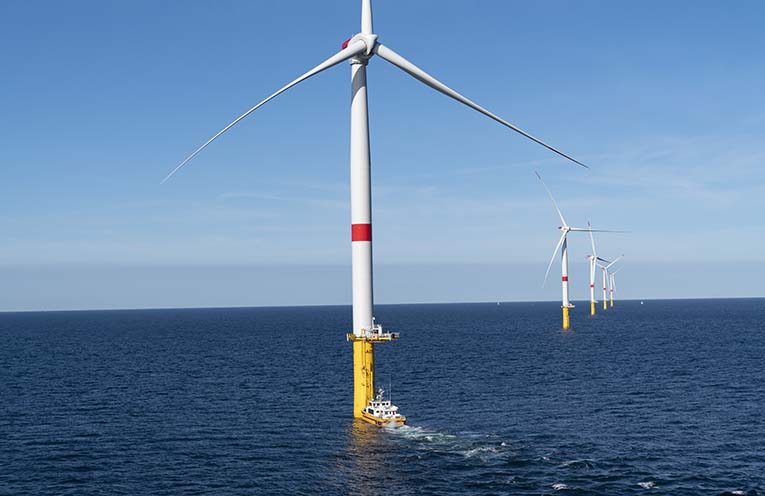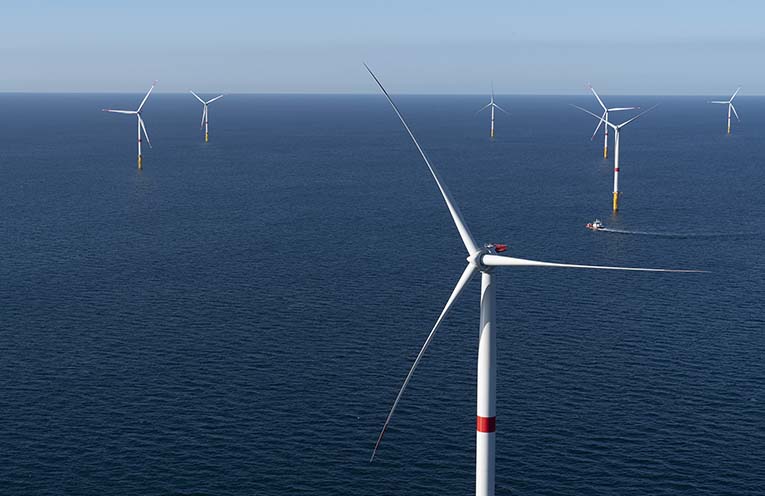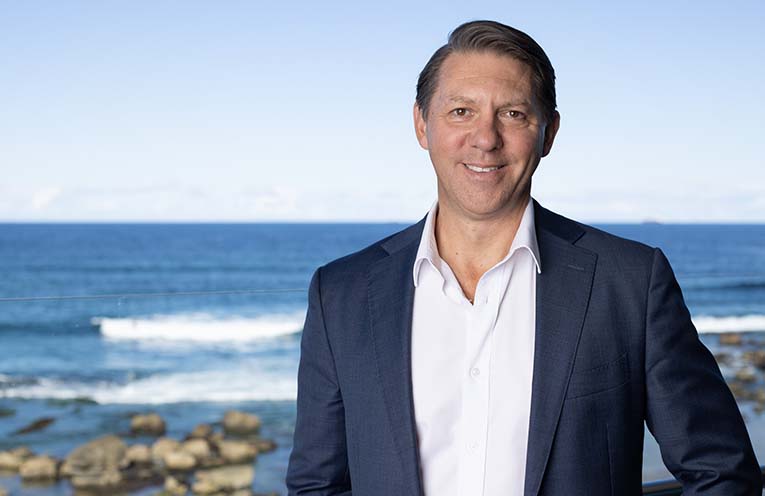
A LEADING global developer of renewable energy projects says if impact studies find the negative impacts of developing offshore wind farms off the Hunter coast to be too great, the wind farms simply won’t be built.
Dave Johnson is the CEO of EDF Renewables Australia, a wholly owned subsidiary of the EDF Group, the second largest generator of electricity in the world and the fifth largest generator of renewable energy.
 Advertise with News of The Area today.
Advertise with News of The Area today.It’s worth it for your business.
Message us.
Phone us – (02) 4981 8882.
Email us – media@newsofthearea.com.au
EDF has its eyes on developing an offshore wind project, known as Newcastle Offshore Wind, in the recently declared 1800 square kilometre Hunter offshore wind zone, and is currently in the process of applying for a Feasibility Licence to explore options for development within the zone.
It should be noted that multiple offshore wind developers, both Australian and international, are likely to apply for a feasibility licence, with industry insiders believing the number of applicants could be as high as 15.
If said licence is granted, EDF will be required to complete rigorous studies and surveys into the impacts of offshore wind development on the declared zone and the surrounding areas.
“Whether you are developing a solar farm, an onshore wind farm or whatever it is, you have to follow the Federal Environment Protection and Biodiversity Conservation Act (EPBC) process.
“You have to study the environment, you have to work out what’s there, you have to rank those species as to whether they are threatened, endangered or whichever category they are in and then you have to work out your impact on those species.
“From obtaining a licence to declaring a successful project, that’s five to seven years of work of doing studies and surveys, doing geotechnical and geophysical investigations, studying the marine environment, working out the impact on fishing, whales and dolphins.
“We need to understand the geotechnical conditions of the seabed.
“We need to understand the geophysical conditions – wind and wave conditions, current conditions, the wind resource itself.
“If your impact is too great then you’re not going to get an environmental approval.”
Mr Johnson told News Of The Area that EDF Renewables Australia recently signed a Memorandum of Understanding (MOU) with the University of Newcastle to engage in studying the zone.
“We met with the Vice Chancellor Professor Alex Zelinsky and we want to use the University of Newcastle to help us do all those studies and surveys.
“That provides that level of independence as well.
“They are very strong in the marine ecology area, so we want them to help us and tell us what the constraints and limitations are.”
It is also likely that offshore proponents will collaborate on studies in order to quantify the cumulative impact of all the projects on the total zone.
Construction cannot begin until the feasibility stage is complete, and environmental and other approvals are in place.
CAN FISHING COEXIST WITH OFFSHORE WIND?
A major discussion point since the announcement of the Hunter offshore wind zone has been the potential impact on commercial and recreational fishing.
Mr Johnson urges patience from fishers, noting international examples where compromise has been reached between offshore wind proponents and the fishing industry.
“France has a very large commercial fishery so the negotiations and interactions with the commercial fishing industry took a long time but they reached agreement.
“At the (offshore wind farm) I was at a couple of months ago we have agreed with the fishing industry that they can fish in between the turbines now.
“There are no exclusion zones – as long as you are a registered fisherman in that region, you are allowed to fish there.
“That certainly wasn’t the starting position, but that was what has been agreed.”
JOB CREATION AND TRANSITION
Mr Johnson believes the Hunter region is uniquely prepared for the development of an offshore wind industry locally, with a high supply of skilled workers needing to transition from the coal industry.
“In construction we are looking at over 2000 jobs for a period of four years.
“In operation, it’s probably 400 jobs.
“You can generally add another 50 percent for indirect jobs.
“I think the opportunity here is to help transition existing jobs from coal industries in the next five to seven years.”
In Europe, in nations such as Poland and Germany, EDF are currently working to retrain coal workers into renewable energy roles.
“We are also working with CS Energy in Queensland, who own and operate the Callide Power Station, which is a three station coal fire powered station in Biloela.
“We have mapped the jobs they have, and the jobs, as those coal stations progressively retire, that will become available to work with us.”
HIGHER TURBINES OR MORE TURBINES?
Following community consultation, the Hunter offshore wind zone was moved further out to sea, at a minimum distance of 20 kilometres from shore off Port Stephens, with infrastructure heights capped at 260 metres.
Mr Johnson believes this indicates the Government’s willingness to listen to the concerns of locals.
“For onshore wind, you can go through the planning approval process and receive approval for 320 metres tip height.
“So the fact that the Minister has gone 60 metres below that shows that he’s seriously taken on the feedback from the local community.”
However, shorter turbines mean less energy production, which may increase the number of turbines needed to generate the 5 gigawatts of electricity the Government hopes to achieve from the zone.
“By height limiting, you can only have blades of a certain height, which means you can only produce so many megawatts in that area.
“If you didn’t have the height limit, you could produce a lot more energy in the same footprint.”
Mr Johnson said that if the Government had approved higher turbines it may have reduced the overall visual impact of the offshore wind development.
“In many respects, it reduces the visual impact by having bigger turbines.
“If you went to the first wind farms they built in South Australia and Victoria, where they were one or two megawatt turbines, it looks very crowded with a lot of turbines.
“If you go to a modern wind farm, for example Rye Park in the Southern Highlands which is being built at the moment, they are six megawatt turbines.
“Because they are so much bigger, there are far less of them.”
WHY OFFSHORE WIND, WHY THE HUNTER AND WHY NOW?
Mr Johnson believes a mix of large-scale renewable energy sources must be developed with some urgency as the state moves away from a reliance on coal.
“NSW has about 8500 megawatts of coal powered generation which is forecast to close by 2035,” Mr Johnson said.
“That generation operates about 24/7 at the moment.
“Solar can replace a portion of it during the day when the sun is shining.
“Onshore wind can replace a portion of it when that operates.
“On the standard day off the Hunter coast, the wind picks up in the afternoon and operates all evening and in the morning.
“Offshore wind fills a renewable energy gap on a daily profile we don’t have elsewhere.
“That is really important for NSW to keep the lights on.”
Again, Mr Johnson said the Hunter region’s long standing relationship with coal provides it with unique advantages in the development of an offshore wind industry.
“The coal powered fire stations are here, so the transmission network in the Hunter is the strongest in the national electricity market.
“You can put a reasonable amount of generation here and connect it in and recycle those same transmission networks without having to build new transmission lines right through the state.
“You have a workforce, you have a port, you have a wind resource, you have the transmission lines – those are all the key factors.”
CAN WIND TURBINES BE RECYCLED?
With 25 years the typical lifespan of wind turbines, and with social images circulating of piles of turbine blades rotting away in landfill overseas, much has been made of the long term environmental impact of offshore wind.
Mr Johnson said that the industry is currently working on strategies to improve the way blades, generally made from fibreglass, are recycled.
“In the next year we are going to decommission fifteen wind farms in Europe which are at end of life.
“EDF has made a commitment to recycle all the blades.”
Mr Johnson acknowledges images of decommissioned turbine blades languishing in landfill is “not a good look” for the industry.
“There are shots taken in Texas where blades are going into landfill.
“That is how things were done 20 years ago – there are materials you can recycle, you just need to be willing to do it.
“There are a number of things you can do with the turbines, they range from grinding them up and using them as concrete additives, to recovering the resin from them.
“In Holland there are bridges that have been built from wind turbine blades.”
Mr Johnson said that development is underway to produce blades which are fully recyclable.
“By the time these (Hunter) wind farms are ready to be built, eight to ten years, there should be considerable advancements.
“There is a lot of work going into designing things to be recyclable rather than thinking of recycling when it is going to the rubbish dump.”
By Doug CONNOR


